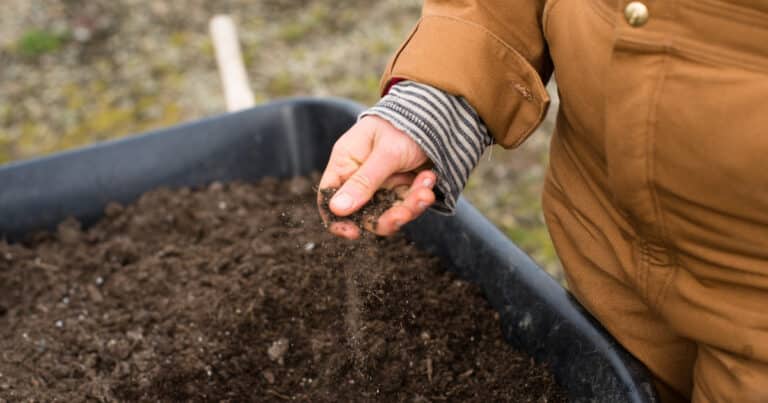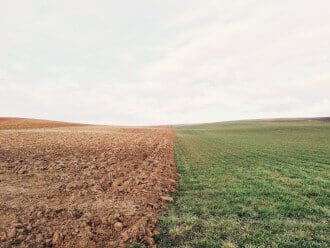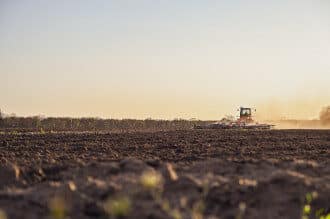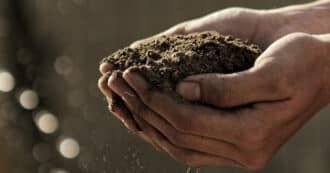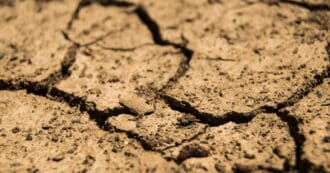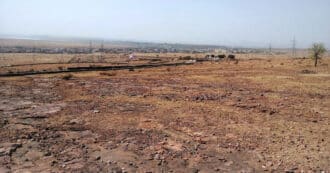By Ethel Mendius – Soil is one of our most essential natural resources and “the basis for all terrestrial life” as a food and life source for plants, animals, and people. Soil exists in abundance, but human activity is leading to a decline in soil quality. This process, known as soil degradation, poses a threat to life on earth.
Soil Erosion, Soil Degradation, and Land Degradation
Soil erosion and soil degradation are interlinked concepts often discussed in the same breath or even interchangeably. For instance, the White House Office of Science and Technology Policy has “announced a nationwide call to action to address soil degradation and erosion.”
Technically speaking, soil erosion is an aspect of soil degradation that “specifically refers to the loss of top soil and soil nutrients.” Soil erosion can result from a natural process such as wind and water erosion, but these processes are accelerated by irresponsible human behavior.
Soil degradation is the leading cause of land degradation, a “broader term referring to the decline of the entire ecosystem’s ability to provide goods and services” such as pollination and carbon storage.
Land degradation is strongly associated with desertification, an irreversible process happening worldwide in which arable land becomes desert. While land is “a complex mixture of soil, water and biodiversity,” we must turn toward soil health to get to the “root” of the issue.
Consequences of Soil Degradation
In addition to supporting 95% of all food production, soil functions to filter water, sequester carbon, and support biodiversity. However, soil and land degradation “is affecting regions inhabited by over one-third of the global population,” and we are starting to see far-reaching consequences.
Ecological Features
Soil degradation is “the physical, chemical and biological decline in soil quality.” In addition to erosion, this process is marked by soil compaction, salination, and nutrient degradation.
All of these factors result in the loss of soil fertility, “the ability of a soil to sustain plant growth.” The harm done is felt by the ecosystem at large, contributing to pollution, affecting the water supply, and impacting soil biodiversity that affects life at all levels.
Soil Degradation and Climate Change
Soil degradation also contributes to climate change. Soil provides a natural storage for carbon dioxide and organic matter. Soil degradation can release this carbon into the atmosphere.
On the other hand, the effects of climate change increase soil degradation. Global warming, extreme weather events, and wildfires precipitated by climate change all worsen soil erosion and lead to further degradation.
Soil Degradation and the Human Population
Even apart from the consequences of climate change, soil degradation poses a direct risk to human life and health. Soil fertility is what allows us to grow crops, and in our increasingly global food system, “one of the biggest threats to our future food security is land degradation and the associated loss in soil productivity.”
According to UN estimates, “12 million hectares of land are lost to drought and desertification each year, a potential loss of 20 million tons of grain.” Furthermore, they predict that “land and soil degradation will reduce food production of the next 25 years by 12 percent.”
Who Is Affected By Soil Degradation?
These processes disproportionately affect populations in the Global South: “the vast majority of people who depend on drylands live in developing countries.”
Women and children are particularly vulnerable to the impacts of soil and land degradation. However, the consequences affects all of the world’s population and will worsen if we do not take measures to prevent soil loss.
Soil degradation that results in all-out desertification leads to abandonment of land and global social instability; these were “contributing factors in the wars in Sudan and Syria.”
What Causes Soil Degradation?
There are several factors that directly influence soil quality. While some are natural processes, the rate of decline we are seeing today is largely the result of human influence. Physical factors of soil degradation lead to erosion: “Rainfall, surface runoff, floods, wind erosion, tillage, and mass movements” can all lead to the loss of topsoil.
Biological factors affect the microbial activity of soil and can affect soil’s ability to grow crops and produce food. Chemical factors, such as the salinity of soil, “bring forth the irreversible loss of soil nutrients and production capacities.”
Human Activity That Affects Soil Quality
Speaking more broadly, much of the soil degradation we see today can be attributed to human practices. Our unsustainable relationship with the natural world is harmful to not just the soil but to the future of all species.
For one, deforestation exposes soil nutrients and removes plant cover, harming the resilience of soil. Urbanization is also harmful, because it “covers the soil in an impermeable layer of concrete that amplifies the amount of surface runoff,” amounting in severe soil erosion.
Much of the soil degradation we see today is the result of pollution from industry and mining. Industrial activities release toxic chemicals into the environment, corrupt organic matter, and through water runoff damage our soil: “Altogether, industrial and mining activities degrade the soil’s physical, chemical, and biological properties.”
Unsustainable Agricultural Practices
Unfortunately, the current agricultural practices we employ on an industrial scale increase soil erosion and degradation in several ways. Poor land management becomes a vicious cycle as we look for quick fixes for the problems it creates.
The industry standard of focusing on one crop (“monocropping”) or at best a simple crop rotation does nothing to preserve soil health, necessitating more fertilizers and pesticides. Furthermore, it “alters the microbial landscape of soil,” affecting plant growth.
Synthetic fertilizers lead to a decline in soil health and result in a build-up of harmful salts and metals, leading to chemical changes that affect crop yield. This practice requires more synthetic fertilizers to supply plant nutrients and maintain agricultural productivity for the next harvest.
Intensive farming practices pose further harms to soil. Pesticides affect its microbial health, killing healthy and harmful bacteria alike, and mechanical tilling and heavy farm equipment leads to the degradation of soil structure. Animal waste from factory farms also contaminates soil with heavy metals and harmful microbes. Taken together, all these industrial farming practices jeopardize the future of our soil system.
The Hidden Cost
Our current relationship with soil and in particular our intensive agriculture practices are not only harmful but inefficient. Soil degradation must be addressed for humankind to be healthy and prosperous.
The solutions we rely on to maintain agricultural productivity without soil health are increasingly costly. A recent study shows “one-third of the fertilizer applied to grow corn in the U.S. each year simply compensates for the ongoing loss of soil fertility, leading to more than a half-billion dollars in extra costs to U.S. farmers every year.”
Human society cannot get around the high cost of soil erosion: “One study estimated global economic losses from soil erosion to be around $8 billion, due to reduced soil fertility, decreased crop yields and increased water usage.”
Promoting Soil Health
The soil erosion and degradation we are seeing today is totally unsustainable. In the Midwestern United States, over 50 billion tons of topsoil have eroded since farming took off in the mid-19th century, “nearly double the rate” that we can maintain.
We can and must take steps to minimize soil erosion and degradation for the benefit of ourselves and our natural environments. These measures involve systemic overhaul as well as lifestyle changes.
Sustainable agriculture, and meaning “responsible regulation of land and agriculture”, and less demand for meat and dairy would curb some of the impacts of soil degradation. Sustainable forest management, planting trees where they have been cut down, has been shown to curb erosion.
Letting the land rest, while being economical with what we are using, is another solution: “it takes around 500 years for just 2.5cm of topsoil to be created,” and at that rate it will be a challenge to make up for the soil we have lost from unsustainable practices.
Soil Degradation and Religion
Soil’s importance and the danger of its degradation appear in cultures around the world. Katsuyuki Minami’s Soil and humanity: Culture, civilization, livelihood and health is a great survey of different culture’s relationship with soil. For example, this article quotes a poem from the Chinese work Hongfan Wuxingzhuan, that speaks of “soil virtue”:
Trees do not grow or flourish without the soil. Fire has no vigor without soil, and it exists as fire only because there is soil. Metal can become useful when it is put in earthen molds. If there were no soil, water would spill over and never stop flowing; water does not spill over because there are dikes.
Soil energy helps new things to sprout and allows that which has weakened to waste away and attain its path. Therefore, the cycle of the five elements is dependent on the power of soil virtue. Soil energy is at the center of seasonal changes, is the driving force behind the seasons, and is the king of the seasons.
The closer people have been tied to the earth, the more they have appreciated soil. Today we in the western world have become more and more estranged from the Earth, and similarly treat soil as a disposable commodity. We farm without concern for future generations, which is the death sentence for a civilization. Listen to how Minami describes the collapse of the Greek empire:
Why did the Greeks fall in a mere 30–40 generations? Like other societies, they depended on agriculture to feed themselves. However, as they increased crop production because of population growth, they plundered soil fertility and abetted soil erosion. As a consequence, the soil resources were exhausted and ecosystem destruction proceeded.
When Greece was strong, it was still able to prosper, despite the degraded soil, by using its colonies for food production. However, when deprived of its colonies, Greek civilization rapidly declined, suggesting that the progress of civilization is limited by the extent to which it can plunder soil resources from nature.
Soil degradation should be a concern for every religious person. God has blessed us with a bountiful Earth and bountiful healthy soil. But protecting these blessings is up to us.
* Featured image source

